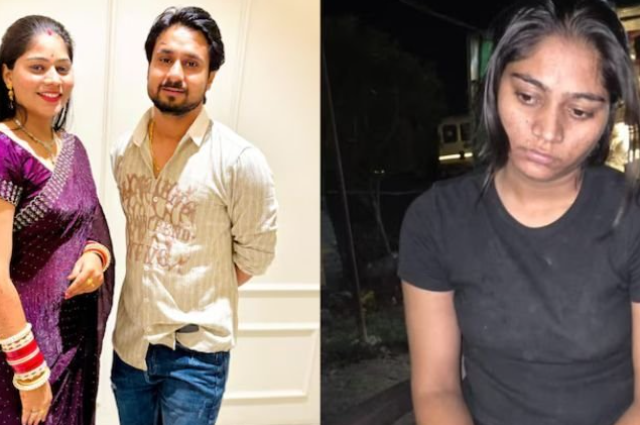
Image by Niek Verlaan from Pixabay
Disclaimer: This article in no way attempts to make any discrimination on the grounds of any sex, gender, colour and place of birth or any other miscellaneous categories directly or indirectly. The article is meant to spread awareness and involves the use of a true storyline that may disturb some people. Readers give consent to read this article as per their own discretion, as it may involve certain parts which might disturb some people for which reflections.live team and writer or any other people associated with this blog directly or indirectly cannot be held liable. The writer and reflections.live team has respect for all opinions and in no way intends to disrespect any thought, expression, belief or opinion.
Marital Betrayal and the Unforeseeable Ending
The mysterious disappearance of an Indore couple in Shillong has brought to emphasise on a miserable act of marital betrayal by forcing us to challenge a deeply troubling societal issue. The case of Raja and Sonam Raghuvanshi serves as a stark reminder that while marriage is often seen as a union of love and commitment, but it can, in extreme circumstances even become a toxic relationship that would lead to unimaginable violence.
The Misleading Honeymoon and a Deadly Plot
What began as a honeymoon trip to the beautiful Northeastern state of Meghalaya for Raja Raghuvanshi, just days after his marriage, has tragically ended in his demise. Unaware to Raja, his newlywed wife, Sonam, had allegedly arranged a sinister plot against him by hiring killers to take his life. Raja vanished shortly after their arrival and his lifeless body was later discovered in a valley by bearing the fatal wounds inflicted by a 'dao,' a traditional local knife. The initial speculation surrounding Sonam's disappearance with theories ranging from kidnapping to being transferred to Bangladesh, had only added layers of complexity to the unfolding tragedy.
However, the truth eventually emerged. In a significant development, Sonam Raghuvanshi was apprehended in Ghazipur in the state of Uttar Pradesh, along with other individuals who were involved in the heinous crime. This breakthrough not only solved the mystery of Raja's death but also exposed the chilling reality of a spouse's alleged involvement in the murder of their partner.
The investigation has now led to the arrest of five individuals, including Raja's newlywed wife, Sonam Raghuvanshi and her alleged boyfriend, Raj Kushwaha. This high-profile case has gathered significant national attention, with the victim's family passionately demanding a thorough investigation and accusing Sonam of a deeper conspiracy.
Key Developments in the Meghalaya Murder Case
On 21st June, a local court in Meghalaya ordered Sonam Raghuvanshi and her alleged boyfriend, Raj Kushwaha, to be held in 13 days of judicial custody. This development follows their arrest in connection with the murder of Raja Raghuvanshi, who was tragically killed during his honeymoon in the northeastern state.
The judicial remand of Sonam and Raj means they will be held in prison as the investigation continues. They join three others already behind bars in connection with the case who are Vishal Chauhan, Akash Rajput, and Anand Kurmi. These three individuals have been identified as friends of Raj Kushwaha and were previously remanded to 14-day judicial custody on June 19th. All five accused are now in judicial custody, a significant step in the ongoing legal proceedings.
A Honeymoon Turned Nightmare: The Timeline of a Tragedy
The tragic events began when Raja Raghuvanshi, originally from Indore had married Sonam on May 11th. The couple embarked on their honeymoon journey to Meghalaya on May 20th. However, just three days later, on May 23rd, Raja was reported missing.
The search for Raja concluded with a horrifying discovery nearly ten days later. On June 2nd, his severely mutilated body was found dumped in a valley near a waterfall in the Sohra region of East Khasi Hills. These ugly findings had strengthened the police investigation.
Following a statewide manhunt, Sonam Raghuvanshi surrendered to the police in Ghazipur, Uttar Pradesh, on June 8th. Subsequently, Raj Kushwaha and his three friends where Vishal Chauhan, Akash Rajput, and Anand Kurmi were apprehended from various locations across Madhya Pradesh and Uttar Pradesh. A Special Investigation Team (SIT) of the Meghalaya Police is currently leading the probe into this complex and high-profile case which has deeply shaken the public.
Family alleges conspiracy and they have demanded NARCO tests
Back in Indore, Raja Raghuvanshi's family has expressed strong scepticism regarding Sonam's statements and her level of cooperation with the authorities. Raja's elder brother, Sachin Raghuvanshi had openly accused Sonam of misleading investigators during her initial eight-day police custody by alleging that she had withheld crucial details about the murder. He has called for Sonam to be remanded in police custody for a longer period to facilitate a more thorough interrogation.
Sachin Raghuvanshi has further demanded that all the accused individuals be brought to Indore for a comprehensive investigation. His goal is to uncover the full extent of what he believes is an elaborate conspiracy behind his brother's murder. In a significant plea, he has also called for narcoanalysis tests not only for Sonam but also for her family and friends, suspecting their potential involvement in a wider structure. He emphasized the complicated nature of the alleged plot, stating, "It is not easy to plan such a massive conspiracy," and reiterated the importance of clearly establishing the motive behind his brother's death.
Mother's suffering resonates nationwide
The grief and anguish of Raja's mother, Uma Raghuvanshi, have resonated deeply across the nation. Overwhelmed by her loss, she has directly questioned Sonam's alleged role in the murder.
"Why did Sonam get my son killed?" she tearfully asked. She has demanded that Sonam, her friends, and all those connected to her be subjected to rigorous interrogation. Uma Raghuvanshi has stated that she will not find peace until she receives a direct answer from Sonam regarding her son's murder, underscoring the profound emotional impact of this tragedy on the victim's family.
The Alarming Absence of "No": A Societal Problem

The core of this heartbreaking incident and indeed many like it lies in the disturbing societal tendency to resort to extreme measures rather than simply exercising the option to say "no" to a marriage. This case underscores a critical message that there is always an alternative and rather, one should not plot a plan to end someone's life.
Consider the various avenues available to individuals who find themselves in unwanted marital situations:
- Before Marriage: If one wants to remain reserved about marriage, the most straightforward approach is to abstain from it entirely. Similarly, if one is in love with another person and does not wish to marry someone else, the power of resistance lies within their hands.
- Parental Disagreement: For those whose parents oppose their chosen beloved, escape remains a historical, although sometimes challenging, option. While not always ideal, it presents a far less destructive path than the alternative seen in Raja's case.
- After Marriage: Even after marriage, if compatibility or dislike issues are reflected for a spouse and it becomes unbearable, divorce provides a legal and morally acceptable means to dissolve the union.
Under no circumstances, however, should anyone resort to destroying another person's life, especially not through murder. Raja's story is an emotional and deeply sorrowful example of an innocent life cut short and what's more distressing is the uninviting realisation that his case is far from being isolated. There are undoubtedly many others unknowingly facing similar threats.
Call for Introspection and Change
The Indore murder case compels us to engage in profound introspection regarding our societal values and the influence of parental upbringing. It raises critical questions about an environment where, for some, the drastic act of hiring contract killers to eliminate a spouse appears to be an easier and more pleasant option than the straightforward act of refusing a marriage or pursuing a divorce. This speaks volumes about the immense pressures, expectations, and possibly even fear that individuals face within certain societal structures.
It is imperative that we, as a society can challenge these toxic norms. We must stand-in an environment where individuals feel empowered to make autonomous decisions about their lives and relationships without fear of severe repercussions, and where the religiousness of human life is supreme. The tragedy of Raja Raghuvanshi should serve as a wake-up call by urging us to re-evaluate our collective outlook on marriage, personal autonomy, and the fundamental right to say "no." Apart from this, the Raja Suryawanshi Honeymoon Murder case will be a precedent wherein it's important to evaluate as a society in which direction we are heading towards?
Marriage turned into a planned murder tells us that as a society, it's important that at the school level itself younger generations are getting educated about gender sensitisation. If it's wrong for a man to commit domestic violence against a woman, likewise it's wrong for a woman to commit a planned murder plot by hiring some contract killers.
Extra Non-standard, Even more Punished: Unpacking Society's Harsh Judgment of Female Criminals
When a woman commits a crime, society's reaction often extends beyond the simple condemnation of the act itself. As Professor G.S. Bajpai, Vice Chancellor at National Law University, Delhi, aptly puts it, "Women aren't expected to do this. When they do, society doesn't just see a criminal — it sees a woman who's 'failed' at being a woman." This profound observation highlights a critical aspect of how female criminality is perceived and punished, a phenomenon British criminologist Frances Heidensohn termed "double deviance."
The Theory of Double Deviance
Heidensohn's "double deviance" theory suggests that a woman who breaks the law not only commits a crime but also violates established gender norms. This dual wrongdoing produces a far more severe societal shrinking than male criminality. As Professor Bajpai elaborates, "She is doubly non-standard and hence must be particularly be punished." Unlike men, who might be stereotyped as impulsive or power-driven when they commit crimes, women who engage in similar acts are often branded as "unnatural," even "monstrous." They face an intensified level of scrutiny with their personal lives where their attire, romantic relationships, social media presence, and even their expressions are meticulously dissected under a harsh public spotlight.
While the National Crime Records Bureau reported over 4.45 lakh crimes against women in 2022, there isn't a standalone category for crimes by women. This is largely due to their statistical shortage. However, as criminal psychologist Deepti Puranik emphasises, "rare doesn’t mean irrelevant." She notes that "crimes committed by women make a disproportionate impact precisely because they upset our cultural expectations." Puranik suggests that societal pressures on women are to suppress emotions, make sacrifices, and remain silent which can eventually lead to "cracks" that sometimes "explode."
These eruptions, she believes that can be fuelled by factors like early marriage, emotional immaturity, a lack of agency, and forced relationships, all of which can result in a significant psychological storm. Activist Yogita Bhayana echoes this sentiment by remarking on the tragic Sonam case: "It became easier for Sonam to plan a murder than to admit she loved someone else. That says a lot more about our society than about her alone." This perspective forces us to consider the societal context that might push women towards extreme actions.
Power or Powerlessness?
A paradox emerges when examining female criminality that are these acts a twisted manifestation of empowerment, or are they born from profound disempowerment? Professor Bajpai offers a nuanced answer by suggesting that while "men often kill for power," women's motivations are "frequently rooted in victimisation, manipulation, or emotional trauma." The world, he observes, struggles to comprehend instances where a traditional "caregiver turns killer."
It's also crucial to remember that intimate partner violence predominantly flows in the opposite direction. "Husbands killing wives is far more common. But those cases don’t dominate headlines in the same way," Bajpai points out. This assertion is supported by data, both globally and in India, which indicates that over half of all female homicides are committed by current or former partners. This highlights a selective focus in media and public discourse when it comes to reporting violence within relationships.
The media's portrayal of accused women often falls into familiar, simplistic archetypes that include the "wife with a lover," the "influencer who went too far," or the "manipulative seductress." This isn't just lazy journalism; it's dangerous. Kulpreet Yadav, co-author of Queens of Crime, correctly identifies that policing, criminology, and media coverage have historically been male-centric. "We don’t truly understand how women with criminal intent think. And that gap leads to oversimplified narratives."
This oversimplification prevents a comprehensive understanding of the complex factors that contribute to female criminality. To truly address these issues, we must move beyond sensationalized labels and delve into the deeper societal, psychological, and systemic issues that may lead women down such tragic paths. Only then can we hope to stand in a more equitable and just response to all forms of crime, regardless of the perpetrator's gender.
A Cry for Justice: The Heartbreaking Case of Atul Subhash and the Burden on Married Men in India
The tragic story of Atul Subhash, a 34-year-old man from Bangalore, sheds light on the quiet yet growing crisis faced by many married men in India. His untimely death by suicide not only reveals the personal anguish he suffered but also brings into focus a legal and social environment that often fails to address the hardships experienced by men in matrimonial disputes.
Atul entered matrimony in 2019 with the hope of building a stable and loving future. However, what began as a new chapter in his life soon transformed into a harrowing ordeal. Within a span of just five years, Atul’s marriage deteriorated under the heaviness of emotional stress, legal complications and repeated confrontations with what he perceived to be part of a biased judicial system.
Before ending his life, Atul recorded a deeply emotional suicide video and left behind a detailed 40-page note. In these, he explained the relentless pressure he faced from his wife and her family. He felt victimized by what he described as one-sided laws that favoured his wife, leaving him little room to seek justice or even peace of mind. These documents offered a painful insight into his deteriorating mental state and the feelings of betrayal and helplessness that consumed him.
Atul claimed that his wife and in-laws demanded an astounding alimony sum of ₹3 crores, a demand he found not only excessive but impossible to meet. Worse still, he was reportedly denied any contact with his child where a punishment that cut him off from one of the most meaningful relationships in his life. He had tried to financially support his wife and her family, yet those efforts were seemingly disregarded.
Allegations of Dowry Harassment and Judicial Corruption
Following the death of his father-in-law, Atul was accused of dowry harassment and a serious charge that carries both legal and social consequences. These allegations which he said, added another layer of suffering as he insisted that they were unfounded and made in bad faith. In a shocking revelation, Atul also alleged that a family court judge demanded a bribe in order to resolve his case. The experience left him feeling utterly disillusioned with the justice system.
Over the span of two years, Atul reportedly attended more than 120 court hearings — a number that in itself illustrates the exhausting legal struggle he faced. Yet, in the end, the court ordered him to pay a monthly maintenance amount he found deeply unfair given his deteriorating financial and emotional condition. He felt that the system had completely failed him.
In one of the most chilling moments from his suicide note, Atul wrote: "I refuse to pay and I choose death." These words are not just a personal outcry — they echo the silent suffering of countless other men who feel trapped by legal obligations and societal stigma with no one to hear their side of the story.
Conclusion
Cases like Atul Subhash’s death and Raja Raghuvanshi's serve as a reminder for society that marriage as an institution is collapsing, and their lives lost must serve as more than just a tragic headline. It is a call to introspect, reform, and create a more balanced legal system that recognises the struggles of all parties involved in matrimonial disputes. Emotional well-being, fair legal treatment, and accessible mental health support must be priorities not just for women, but for men too. Lastly, it's always recommended to exercise the option of ‘No’, rather than resorting to some extreme steps that have a horrible impact on society.
. . .
References:
- https://timesofindia.indiatimes.com/india/throw-my-ashes
- https://www.ndtv.com/india-news/techie-atul-subhash
- https://timesofindia.indiatimes.com/india/honeymoon-murder
- https://economictimes.indiatimes.com/magazines/panache
- https://timesofindia.indiatimes.com/city/guwahati
- https://www.indiatoday.in/india/story/raja-raghuvanshi-murder

